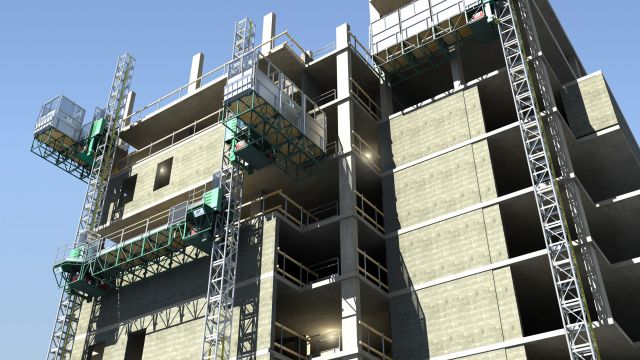The continued rise of equipment rental
Growth projected through 2015
By Wayne Walley
In 2013, total equipment rental revenue in North America, which includes the United States and Canada, increased 6.2 percent to reach $38 billion. In 2014, revenue is expected to grow another 7.5 percent to reach $40.8 billion, according to the latest American Rental Association (ARA) forecast from the ARA Rental Market Monitor.
Growth is projected to accelerate in all segments through 2015, before growth slows in 2016 and 2017. Equipment rental revenue in 2015 is forecast to grow 10.4 percent to reach $45 billion, with an expected growth rate of 9.3 percent in 2016 and 7.7 percent in 2017, with total revenue reaching $53 billion in 2017.
According to the ARA Rental Market Monitor, the general tool segment will have the highest compound annual growth rate (CAGR) at 10.7 percent during the five-year forecast. Construction and industrial equipment revenue, driven by a stronger U.S. construction market, is forecast to see a CAGR of 9.2 percent between 2013 and 2017 in North America.
In the United States alone, total rental revenue in 2014 is forecast to reach $35.9 billion, up 7.7 percent, fueled by a 8.2 percent increase in construction and industrial rental revenue and an 7.3 percent increase in general tool revenue.
Both those segments are expected to hit double-digit growth in the United States in 2015, with construction and industrial revenue projected to increase 11.0 percent and general tool 13.2 percent.
As a result, the new ARA Rental Penetration Index shows a one-year increase of 220 basis points to reach 52.9 percent.
In short, the findings support the idea that more contractors and construction companies are turning to equipment rental as an efficient way to complete projects.
“The rental penetration number is a fleet penetration number, that is how much of the total equipment fleet is comprised by the rental industry,” says Scott Hazelton, a senior partner with IHS Global Insight, the research company that partners with ARA to compile data for the ARA Rental Market Monitor and the ARA Rental Penetration Index.
“A leading indicator of fleet penetration is sales penetration, such as how much of current year equipment sales goes into rental fleets,” he continues. “There is a consensus that sales penetration was around 60 percent in 2013, which suggests that rental fleet penetration has room to grow.”
Hazelton added that, while rental penetration tends to grow most quickly during the first part of an economic expansion, it will plateau as the expansion nears its peak. An explicit forecasting equation for rental penetration isn’t available, the most likely path is for another one or two years of increases at decreasing rates of growth.
While some contractors will likely begin to buy some equipment directly, Hazelton says there is evidence of a secular shift to rental: “The historical data for rental penetration requires careful study across several data sources. However, we have spent significant time analyzing it and found that there is a pattern. In downturns, rental penetration falls. This is a good thing for rental companies; they are able to offload unproductive assets faster than contractors can de-fleet, which means they have less capital tied up with no return.
“With the next up-cycle, rental penetration improves again,” he says. “The important element is that in each downturn, rental gives back less penetration than it gained in the up-cycle. What we then have is something of an increasing step function; each plateau is at a higher penetration level than the previous one. This is compelling mathematical and even visual proof for a secular shift to rental. We do not see a down cycle in the next five years, so there is not yet a scenario in view that would yield any decline in rental penetration.”
Hazelton says the growth in revenue for the equipment rental industry continues to outpace the industries it serves with significant increases, including the 11 percent forecast for 2015.
However, according to IHS Global Insight, residential construction is forecast to grow 6.5 percent in 2014 and 19.3 percent in 2015. Commercial construction is forecast to grow at 11.2 percent in 2014, 18.7 percent in 2015 and then 31.5 percent in 2016, all of which could benefit the rental industry.
“To date, we have been seeing rental revenue grow in an economy that has been playing catch-up,” Hazelton says. “That is, the economy has been growing, but much of that growth, simply put, existing capacity – both labor and capital – back to work. Rental certainly did well in this environment. You still need equipment to renovate space, upgrade plants, increase production and more. However, the forecast holds the promise of net new demand.”
Hazelton adds that this already is a trend in housing, and we will see a lot more of it in housing during the next couple of years. With increased employment comes increased household formation – new individuals and families striking out on their own. This translates into demand for new housing units. In the near term, this already has led to a boom in multi-family construction, but it will increasingly include single-family homes with time, he says.
“The demand for rental equipment for residential construction has not historically been strong, although it provides some lift, especially within the general tool segment,” Hazelton says. “However, there is a reliable pattern of nonresidential activity within 12 to 18 months of a housing recovery as the consumer demand from the new housing is met. Housing developments typically are followed by retail, banking and health care construction and, in many cases, by new educational and other government building, such as emergency services and transportation construction as well. This construction activity is equipment rental intensive.”
Originally published in Masonry magazine.
About the Author
Wayne Walley is editor of RENTAL MANAGEMENT, the magazine of the American Rental Association. Visit www.ararental.org for more information.



















